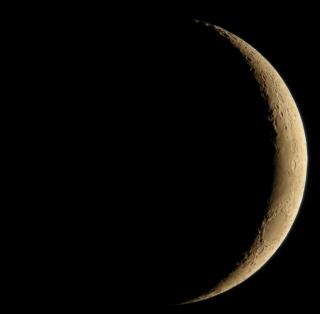Today was a glorious Martin Luther King day, except for the fact that I didn’t get to celebrate it as a holiday. Instead, I was inside, chained to my desk all day. So when I got home tonight, and finally finished the last conference call of the day, I grabbed the opportunity for my “garbage moment” with both hands. (If you’re familiar with the cute but not particularly funny comic, Rose is Rose, you know what a garbage moment is: that moment when Dad gets to commune with the great outdoors while taking care of the domestic chores.)
And tonight’s garbage moment included a glimpse of a stunning three-day-old moon:
Needless to say, I was thrilled to be able to steal enough time from my family, chores, and job, to shoot the moon so soon after getting shots of the 1-day-old moon and 2-day-old moon. I doubt I’ll be able to get the complete lunation, but these three days are a pretty good start!
As you can see from the relatively poor quality of the photos, I have much to learn about digiscoping the moon. These days, all the best earth-based photography seems to be accomplished via expensive CCD camera outfits on expensive scopes, or on cheap webcams, which can take hundreds of frames and stack them all together to achieve some incredibly fine detail.
My shots are just digiscoped: I slap my point and shoot Nikon onto a little bracket that fits over the eyepiece of my little 60-mm spotting scope. I don’t expect perfection; in fact, I’m tickled that tonight’s shots turned out so well (the first two shots are from Saturday and Sunday, respectively; in all photos, south is up and east is to the right of the image):
As you can see from today’s photos, Mare Crisium is completely visible by day three; you can even see the prominent craters Peirce and Picard in the large crater Cleomedes (the first large crater “below” Mare Crisium; right below that is Burckhardt and then Geminus). Well, you can see Peirce and Picard if you have the original image and zoom in on it a little bit; on this platform you really have to know what you’re looking at to tell they’re there. Or you can click the link above, which will take you to Antonio Cidadao’s shot of Peirce; you really should spend some time on his site if you’re at all interested in the moon.
But look how different the moon is after 25 hours; last night the stars of the show were the four-crater chain Langrenus-Vendelinus-Petavius-Furnerius; tonight the star attractions are the Mare Crisium herself and surrounds. Two other craters are fairly prominent about halfway between the L-V-P-F chain and the terminator: these are Snellius (the one that looks somewhat oval, although it is, like most craters on the moon, pretty close to circular) and Stevinus.
Hope you enjoy these little lunacies of mine; maybe I’ll get all of 2010’s Winter Moon on “film.”



























